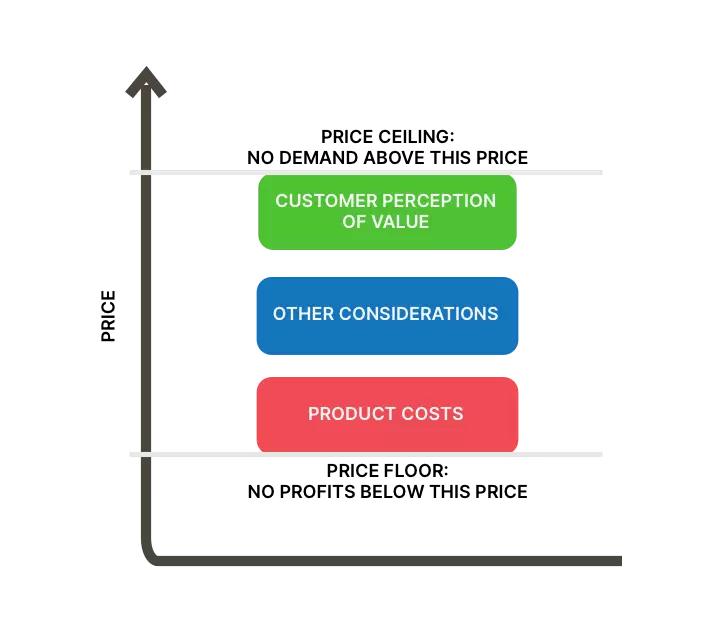For every product, the company has to choose a price. But determining the price can take many ways. Most importantly, it should follow a predetermined strategy. 3 major pricing strategies can be identified: Customer value-based pricing, cost-based pricing, and competition-based pricing. Which one should you select? We explain the 3 major pricing strategies.
Whatever price you choose, it will fall somewhere between one that is too high to generate any demand and one that is too low to cover your expenses. It is somewhere between a price ceiling and a price floor. Customers’ perceptions of the product’s value set the price ceiling. If customers perceive that the product’s price is higher than its value, they will not buy the product. On the other extreme, product costs set the price floor. If the product’s price is lower than its costs, the company will make losses.
As said, 3 major pricing strategies help to find the right price between these two extremes.

In setting the price between these two extremes, the firm must consider several internal and external factors. These include competitors’ strategies and prices, the overall marketing strategy and mix, and the nature of the market and demand. Let’s take a look at the 3 major pricing strategies.

Customer value-based Pricing
Good pricing usually starts with customers and their perceptions of value. Eventually, the customer will decide whether a product is worth its price or not. Therefore, we start with customer value. When customers buy a product, they exchange something of value (the price) to get something of value (the benefits of having or using a particular product). Therefore, it is crucial to understand how much value consumers place on the benefits they receive from the product and set a price that captures exactly this value.
Summing these considerations up, we can say that customer value-based pricing uses buyers’ perceptions of value as the key to pricing, instead of the seller’s costs. This also means that we cannot design a product and marketing program and then set the price. Price is considered along with all other marketing mix variables before the marketing program is set.
Cost-based Pricing
While in customer value-based pricing, customers’ perceptions of value are key to setting prices, in cost-based pricing the seller’s costs are the primary consideration. Costs set the floor for the price that the company can charge. Therefore, cost-based pricing involves setting prices based on the costs of producing, distributing, and selling the product. To make some profit, a fair rate of return is added to account for efforts and risks.
Some companies, such as Ryanair or Walmart, pursue a low-cost strategy and aim to offer the lowest prices. This goes along with accepting smaller margins but greater sales. Other companies, such as Apple or BMW, do not compete based on low prices. By offering superior customer value, they can claim higher prices and margins – they pursue a customer value-based pricing strategy. We can see that choosing between the 3 major pricing strategies is closely related to the overall marketing strategy – actually, it is an integral part of it.
Competition-based Pricing
Finally, competition-based pricing involves setting prices based on competitors’ strategies, costs, prices, and market offerings. In highly competitive markets, consumers will base their judgments of a product’s value on the prices that competitors charge for similar products. For instance, in the gasoline industry, competition-based pricing is applied.
However, in assessing competitors’ pricing strategies, the company should ask several questions. First of all, how does the company’s market offering compare with competitors’ market offerings in terms of customer value? If consumers perceive that the company’s product provides greater value, the company can charge a higher price. Secondly, how strong are current competitors, and what are their pricing strategies? If the market is already dominated by large, low-price competitors, the company may be better advised to target unserved market niches with value-added products and prices.






